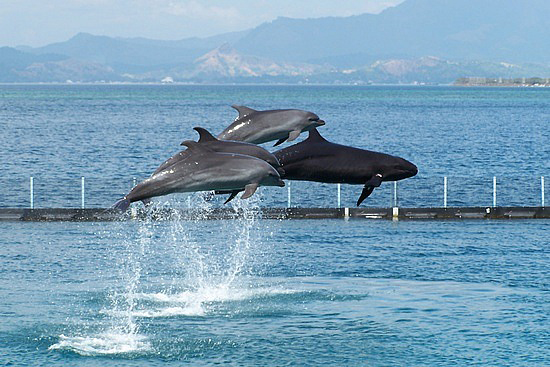ALAMINOS CITY, Pangasinan – The famous Hundred Islands in the Lingayen Gulf has an added attraction – the visiting dolphins.
In fact, dolphin-watching could be the newest eco-adventure activity in the Hundred Islands National Park (HINP) next to kayaking, bird-watching, snorkeling, diving, nature photography and island-hopping, according to Dr. Lemuel Aragones, associate professor of the Institute of Environmental Science and Meteorology of the University of the Philippines and former professor at the University of Miami in Florida.

Dr. Aragones was here for a one-day planning workshop on marine mammal visitation upon the invitation of the Alaminos city government.
Aragones, a co-convenor of the Philippine Marine Mammal Stranding Network (PMMSN), said the new attraction needs a lot of studies and preparation.
More than 20 of the friendly sea creatures were seen by Mayor Hernani A. Braganza and city general services office and POSO (Public Order and Safety Office)-Bantay Dagat personnel last December 6 at the Lucap Bay Area while they were on board a motorized banca.
Aragones, who was first here in 2008 to help save a stranded rough-toothed dolphin, named “Bayanihan”, lectured on marine mammal stranding and watched and studied the video footage of the recent dolphin sightings at Lucap Bay.
He was easily convinced that based on the footage, these belonged to short-finned pilot whales.
Aragones showed his file photos of different species of dolphins and compared it with the video footage uploaded to the YouTube and the city’s Gali-La Alaminian Facebook account to substantiate his claim.
“They are whales but considered dolphins since they belong to the Delphinidae family,” he said, adding that dolphins can easily be distinguished through their fins, size, color and behavior.
Although the dolphins and two baby whale sharks (butanding) sighted at the Hundred Islands last October were not stranded, Aragones said residents must understand how to respond to possible eventualities in the future.
He proposed a two-day training-seminar on Marine Mammal Stranding Response early next year here that would also include another whole-day hands-on training at the Ocean Adventure in Subic, Zambales.
A marine mammal stranding is an event in which an individual or group of marine mammals washes ashore after dying or is found on the beach or shore in a helpless situation and unable to return to the water on its own.
Marine mammals are said to be out-of-habitat when they are found close to shallow waters and likely at risk of becoming stranded.
In the case of the dolphins and a baby whale seen in the city, Aragones said that the marine mammals might be enjoying the “alamang” (small shrimps), their favorite food which are now abundant in the Hundred Islands.
“This is the time of the year where there is oversupply of ‘alamang’ and other plankton in the western coast,” he added.
There is also the possibility that the dolphins might have been affected by dynamite fishing which is still rampant in the Lingayen Gulf area and some provinces particularly Zambales, Ilocos Norte and Cagayan, which he said are three of the nation’s marine mammal stranding hotspots,” he pointed out.
But Aragones is more convinced that the presence of these natural food and are free from various human threats have attracted the marine mammals to keep on coming back at the city’s marine park.
“Dolphins and whales are indicators of the health and condition of the coastal waters and the ocean in general,” said Aragones, a former professor of the University of Miami in Florida, USA.
He lauded the program and the political will of the administration of Mayor Braganza in protecting the city’s territorial waters from illegal fishing activities.
The mayor has completely stopped dynamite fishing in all of the Hundred Islands since 2004.
Aragones likewise cited Braganza for instructing the POSO-Bantay Dagat and GSO (General Service Office) composite team on guiding back the dolphins to the deeper part of the sea and ensuring round-the-clock that they will not be harmed by anyone.
Aragones also appreciated the timely initiative of the city government in forming an alliance with coastal towns in the province, similar to One Pangasinan Alliance of LGUs,in responding to marine mammal stranding and ultimately in promoting dolphin watching as an alternative livelihood for people.
Dolphins and whales making a regular visit at the Hundred Islands is indeed a welcome development, an amazing spectacle to behold, he added.
The city government is upbeat that the Hundred Islands could become not just a temporary playground or food bowl for these friendly marine mammals but ultimately, as their new habitat.
Mayor Braganza said this could translate to better opportunities for the city folks and new source of pride for the city.



 ShareThis
ShareThis